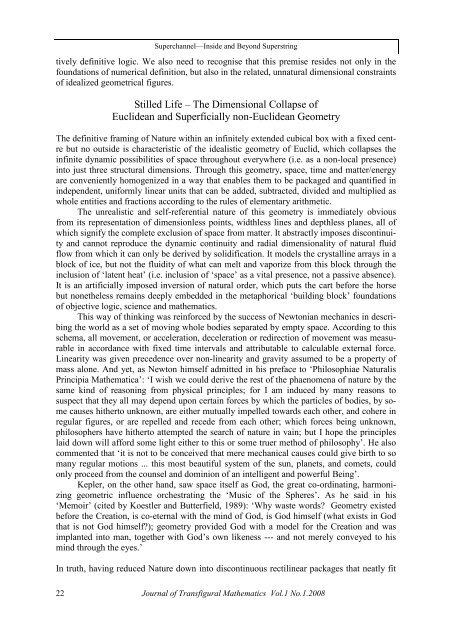JTfM Vol 1 No 1 2008 - ONLINE EDITION - Inclusionality Research
JTfM Vol 1 No 1 2008 - ONLINE EDITION - Inclusionality Research
JTfM Vol 1 No 1 2008 - ONLINE EDITION - Inclusionality Research
Create successful ePaper yourself
Turn your PDF publications into a flip-book with our unique Google optimized e-Paper software.
Superchannel—Inside and Beyond Superstring<br />
tively definitive logic. We also need to recognise that this premise resides not only in the<br />
foundations of numerical definition, but also in the related, unnatural dimensional constraints<br />
of idealized geometrical figures.<br />
Stilled Life – The Dimensional Collapse of<br />
Euclidean and Superficially non-Euclidean Geometry<br />
The definitive framing of Nature within an infinitely extended cubical box with a fixed centre<br />
but no outside is characteristic of the idealistic geometry of Euclid, which collapses the<br />
infinite dynamic possibilities of space throughout everywhere (i.e. as a non-local presence)<br />
into just three structural dimensions. Through this geometry, space, time and matter/energy<br />
are conveniently homogenized in a way that enables them to be packaged and quantified in<br />
independent, uniformly linear units that can be added, subtracted, divided and multiplied as<br />
whole entities and fractions according to the rules of elementary arithmetic.<br />
The unrealistic and self-referential nature of this geometry is immediately obvious<br />
from its representation of dimensionless points, widthless lines and depthless planes, all of<br />
which signify the complete exclusion of space from matter. It abstractly imposes discontinuity<br />
and cannot reproduce the dynamic continuity and radial dimensionality of natural fluid<br />
flow from which it can only be derived by solidification. It models the crystalline arrays in a<br />
block of ice, but not the fluidity of what can melt and vaporize from this block through the<br />
inclusion of ‘latent heat’ (i.e. inclusion of ‘space’ as a vital presence, not a passive absence).<br />
It is an artificially imposed inversion of natural order, which puts the cart before the horse<br />
but nonetheless remains deeply embedded in the metaphorical ‘building block’ foundations<br />
of objective logic, science and mathematics.<br />
This way of thinking was reinforced by the success of Newtonian mechanics in describing<br />
the world as a set of moving whole bodies separated by empty space. According to this<br />
schema, all movement, or acceleration, deceleration or redirection of movement was measurable<br />
in accordance with fixed time intervals and attributable to calculable external force.<br />
Linearity was given precedence over non-linearity and gravity assumed to be a property of<br />
mass alone. And yet, as Newton himself admitted in his preface to ‘Philosophiae Naturalis<br />
Principia Mathematica’: ‘I wish we could derive the rest of the phaenomena of nature by the<br />
same kind of reasoning from physical principles; for I am induced by many reasons to<br />
suspect that they all may depend upon certain forces by which the particles of bodies, by some<br />
causes hitherto unknown, are either mutually impelled towards each other, and cohere in<br />
regular figures, or are repelled and recede from each other; which forces being unknown,<br />
philosophers have hitherto attempted the search of nature in vain; but I hope the principles<br />
laid down will afford some light either to this or some truer method of philosophy’. He also<br />
commented that ‘it is not to be conceived that mere mechanical causes could give birth to so<br />
many regular motions ... this most beautiful system of the sun, planets, and comets, could<br />
only proceed from the counsel and dominion of an intelligent and powerful Being’.<br />
Kepler, on the other hand, saw space itself as God, the great co-ordinating, harmonizing<br />
geometric influence orchestrating the ‘Music of the Spheres’. As he said in his<br />
‘Memoir’ (cited by Koestler and Butterfield, 1989): ‘Why waste words? Geometry existed<br />
before the Creation, is co-eternal with the mind of God, is God himself (what exists in God<br />
that is not God himself?); geometry provided God with a model for the Creation and was<br />
implanted into man, together with God’s own likeness --- and not merely conveyed to his<br />
mind through the eyes.’<br />
In truth, having reduced Nature down into discontinuous rectilinear packages that neatly fit<br />
22<br />
Journal of Transfigural Mathematics <strong>Vol</strong>.1 <strong>No</strong>.1.<strong>2008</strong>




